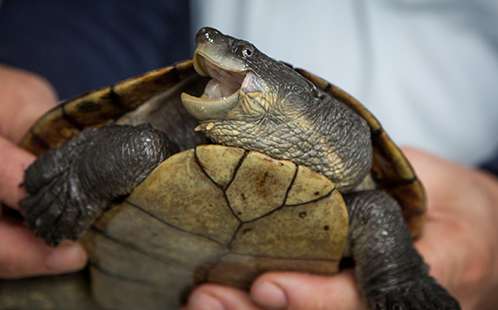Citizen scientists sought to help save turtles from extinction

As turtles in Australia leave the safety of their nests and head to dry land to mate this November, Western Sydney University researchers are calling on Australians to log any sightings on a web app.
To help track turtle populations, Western Sydney University has developed TurtleSAT to identify nesting grounds and areas where turtles are at risk, and provide local assistance where possible.
Lead researcher Dr Ricky Spencer, from the School of Science and Health, says Australian turtles have existed for 50 million years, but in less than 200 years of European settlement they have been driven to the brink of extinction.
"By recording turtle sightings into TurtleSAT from your phone, tablet or computer, you are directly saving a species from inevitable extinction," says Dr Spencer.
"We are urging all Australians to look out for them on roads and record them, alive or dead, into TurtleSAT. If we know where they are crossing roads or nesting, we can better manage these areas and hopefully provide them some help."
"A single female freshwater turtle may live more than 100 years and produce more than 2000 eggs in her lifetime, so any death is significant."
Dr Spencer says some populations along the Murray River have declined by 90%, and TurtleSAT has already recorded widespread carnage throughout southern and eastern Australia from road deaths during the nesting season.
In addition to road deaths, foxes destroy 95% of turtle nests throughout their range in Australia, but standard fox management techniques are proving ineffective.
He says one solution to nest predation may involve making better use of integrated wetlands and sewerage treatment plants.
"Areas such as these are biodiversity hotspots that may offer refuge for many turtle species, but more importantly, provide source populations for translocating hatchling turtles throughout a region," he says.
"Our computer models show that one harvest population may provide enough hatchling turtles to restore 25 other similar sized populations to pre-European turtle densities."
"Creating low cost 'turtle nurseries' throughout the country will provide a way to out-fox the fox without a single poison bait or bullet."
Fun Turtle Fact: Many Australian Turtles can breathe through their behinds like a fish. Cloacal bursae are gill like structures in their cloacas (bottoms), meaning that when they are hibernating in winter, they don't need to come up for air very much. Degrading our river systems reduces the amount of dissolved oxygen in the water, making it harder for them to breathe via this system.
Provided by University of Western Sydney




















